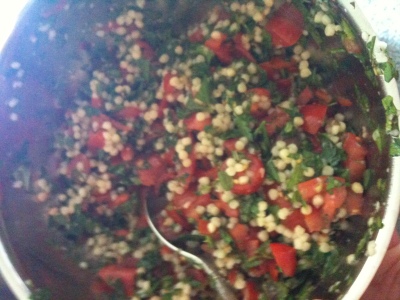 I don’t know about you, but I really hate it when you come across a delicious recipe, only to realize that you only have a handful of the 20 ingredients called for. It’s just not economical to go buy a bunch more ingredients to make one dish!
I don’t know about you, but I really hate it when you come across a delicious recipe, only to realize that you only have a handful of the 20 ingredients called for. It’s just not economical to go buy a bunch more ingredients to make one dish!
Last week I had tomatoes, cucumbers, mint, and parsley from the garden and really really wanted to make tabbouleh salad. The only problem, I discovered as I opened my pantry, was that I did not have any bulgur/cracked wheat. I was not about to run to the grocery store to get one ingredient for a salad. After rummaging through my pantry, I did find large couscous pearls, and decided to try using that as a substitution for bulgur. WELL, it turned out great. I actually like it SOOOO much better than traditional tabbouleh!
What did I learn from this little experiment? That substitutions will often work just as well or better than the original ingredients of a recipe! I found this great online tool that gives you suggestions for substitutions if you’re missing an ingredient or two. It doesn’t cover every ingredient, but its pretty darn helpful! http://www.deliciousdeliveriesinc.com/images/substituteingredients.pdf
– 1 cup pearled couscous, cooked according to directions on package and rinsed thoroughly with cold water after cooking – 1 cup chopped tomatoes – 1 cup finely chopped cucumber – 1-2 cups chopped parsley – 1/2 cup finely chopped mint – garlic salt to taste (or fresh garlic) – onion powder to taste (or fresh onion) – olive oil (about 3 Tbsp) – lemon juice (about 3 Tbsp)Have a happy healthy day!
Caitlin




![photo[1]](https://thehealthywifedotcom.files.wordpress.com/2011/04/photo11.jpg?w=225&h=300)